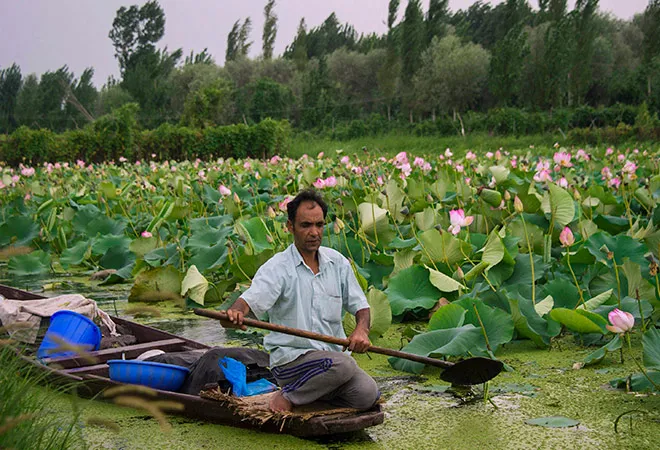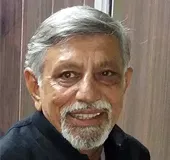-
CENTRES
Progammes & Centres
Location
The Supreme Court is hearing the case against Article 35A. A decision at this juncture against it could once again plunge Kashmir into turmoil.

Image Source: S. Irfan/PTI
Making an unexpected shift from the government’s earlier policy, Home Minister Rajnath Singh has announced the recommencement of the dialogue process in Kashmir, with the appointment of Dineshwar Sharma, a former Intelligence Bureau (IB) Director, as the Centre’s interlocutor. Sharma has been given a free hand to interact with any group or member of society, seeking the aspirations of the people, to enable the Centre to move forward with a possible solution. The Centre’s earlier policy was that it would not talk to the Hurriyat, whom it considered as anti-nationals. Hurriyat was once considered to be the voice of the Kashmiris.
While the step has been welcomed by the BJP’s ruling ally in the state, the PDP, the opposition party, the National Conference, remains cautious, waiting and watching.
The Congress claimed that the government is finally on the right track, having adopted a failed hard policy for the past few years.
Sharma is neither the first, nor likely to be the last interlocutor for the central government. K.C. Pant, former Defence Minister, and N.N. Vohra, the present Jammu and Kashmir Governor, were the first two interlocutors for the Centre. They had initiated dialogue with vast sections of society. The UPA-I government, headed by Manmohan Singh, had appointed five working groups on J&K, including the one headed by the former Vice President, Hamid Ansari. These groups had submitted their recommendations to the Centre.
Prime Minister Manmohan Singh, in his second term, appointed three interlocutors, Dileep Padgaonkar, Radha Kumar and M.M. Ansari, who had also submitted their report. Manmohan Singh also held a series of round table conferences on J&K. None of the reports of the interlocutors nor working groups ever saw the light of day and majority of their recommendations were never implemented. No official reasons have been given for the same.
Thus, it is evident that while the opposition may criticise, but when they possessed the opportunity, their home ministers only voiced suggestions but failed to take any worthwhile step, while reports of the collection of committees and interlocutors gathered dust. Even previous state governments preferred status quo, as it suited them. Violence and an anti-Centre stance kept them in power and power is the end all of politics, the means may vary.
The atmosphere in the Valley presently appears to be congenial for arriving at a midway solution, provided the government possesses the desire to push hard, employing resources at its power. A number of factors have changed, necessitating a fresh look into issues facing the state, possibly even ignoring the earlier reports of interlocutors.
The state is limping back to near normalcy (normalcy is still some distance away), after a prolonged period of unrest. The encounter elimination of Burhan Wani led to sponsored violence, enhanced infiltration and casualties to protestors. The state government had almost handed over the control of the Valley to security agencies.
The terrorists appeared to be gaining ground before the army went into operation ‘all out’, reducing their strength in anti-militancy operations, with enhanced anti-infiltration measures.
While terrorist related activities have reduced, the morale of militants is also low, compelling them to attack soft targets, including police and locals to indicate their presence. This change in trend has begun alienating them from the masses, as is evident from the increased flow of information to security agencies. This has enhanced the success rate of encounters. This year alone almost 165 militants have been eliminated. The local public in villages is turning away from militants, seeking closer cooperation with security agencies. Shortage of funds from across the border is compelling militants to target banks in desperation, to pay its cadres.
While terrorist related activities have reduced, the morale of militants is also low, compelling them to attack soft targets, including police and locals to indicate their presence.
The Hurriyat, which appeared to possess no shortage of funds, due to largesse from Pakistan, could orchestrate violence at will. They appeared to be ruling the roost, pushing governments on the backfoot. For decades, they were the untouchables, being provided security and funding from the state and Centre, with a hope that they would change their spots, which they refused, becoming only more rigid in their demands. Demonetisation, NIA and ED raids on hawala funding began impacting their control. Leaked news in every media channel on the possession of illegal and benami properties by them and their kin at the cost of casualties to locals, reduced their standing in the public eye.
When they and their kin began being summoned by investigating agencies, their calls for bandhs seeking support were ignored. With most behind bars, others on the way, their power is on the wane. With all funds blocked, there is no money to sponsor violence or even terrorism, hence scales have reduced. They are aware that their crimes have been exposed and they would be tucked away in prison, far from their area of influence.
The NIA and ED raids, subsequent investigations, grilling and incarceration has softened them enough to realise that their days are numbered. With some of them singing like canaries, hoping for a reduced sentence, their top hierarchy has become aware that they are next in line. Hence, probably they would try to establish links with the government seeking truce and willing to adopt a softer approach in their otherwise rigid demands. Who better than an interlocutor, an ex-IB director, aware of the Hurriyat and its funding, to whom they can put forward their now softened demands.
This changed environment had never existed in the state in recent times. The Hurriyat only spoke of UN resolutions, the youth of azadi and locals considered the Indian army as occupiers. The Hurriyat is now a spent force, the locals have slowly changed, disgusted with the behaviour and exploitation by militants. While violence by the youth at encounter sites has reduced, their demands for azadi may not have. Hence, Sharma would need to move fast and gain the maximum from interacting with the maximum, to enable the government to strike, while the iron is still hot.
The most important community which needs to be engaged at length is the youth. They were born under the gun, witnessed calls for prayer of only one religion, faced the wrath of security forces, brainwashed into believing that independence is the only solution and have had very limited opportunities to grow beyond stone throwing and countering security forces operations. They desperately need opportunities, preferably away from the state, if they must be weaned away from their brainwashed demands of azadi. Further, it is only by interaction can they be convinced that azadi is not feasible, while other demands benefitting them may be.
They (the youth) were born under the gun, witnessed calls for prayer of only one religion, faced the wrath of security forces, brainwashed into believing that independence is the only solution and have had very limited opportunities to grow beyond stone throwing and countering security forces operations.
Amongst other important groups are those who have suffered the maximum financially in the state, the traders and those dependent on tourism, which was the mainstay of the state. They would need a reassurance that their troubles would be looked into and the Centre would work towards resolving their problems. Similar reassurances would be essential for other small handicraft manufacturers, who presently struggle to survive.
Village elders, political parties and the Hurriyat would always remain stakeholders in the process and their inputs would be equally important. The Centre may consider meeting some demands within the accession document, to establish a positive move forward.
Pitfalls are immense. The Supreme Court is hearing the case against Article 35A, an issue very sentimental to local Kashmiris. A decision at this juncture against it could once again plunge the Valley into turmoil. The Centre needs to keep this under consideration. Any action by militants or security forces causing large scale casualties could turn this conducive atmosphere on its head.
While the task has magnitude, time remains of essence. Winters are approaching, before which the security agencies seek to eliminate militant leaders, bringing in an environment more conducive to peace and development. It is within this time that the new interlocutor must aim to show the seriousness of the Centre.
There is always a doubt in the minds of the locals whether the Centre is truly serious, or is it seeking another option to delay decision making. Previous interlocutor’s reports have gathered dust, will this also? The pace at which Sharma moves will indicate the determination of the Centre. For now, it is wait and watch.
The views expressed above belong to the author(s). ORF research and analyses now available on Telegram! Click here to access our curated content — blogs, longforms and interviews.

An alumnus of the National Defence Academy Major General Harsha Kakar is a graduate of the DSSC LDMC and the National Securities Studies Course at ...
Read More +